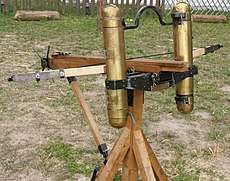Scorpio (weapon)
The scorpio or scorpion was a type of Roman torsion siege engine and field artillery piece. It was described in detail by the early-imperial Roman architect and engineer Vitruvius[1] in the 1st century BC and by the 4th century AD officer and historian Ammianus Marcellinus.[2]
 | |
| Part of a series on the | |
| Military of ancient Rome | |
|---|---|
|
|
|
| |
Design
Two versions are known; a horizontal two-armed variety like a ballista and a one-armed, vertical version otherwise referred to as an onager. The fourth century army officer and historian Ammianus Marcellinus witnessed the use of scorpiones during several engagements in the Persian wars of Constantius II, and described the one-armed version as synonymous with the onager, with the vertical upraised arm as the 'scorpion's sting'.[2]
The complexity of construction and in particular the torsion springs (which the Romans referred to as tormenta) led to great sensitivity to any variation in temperature or moisture, which limited their use. While this type of technology continued to be used in the Byzantine Empire, which was the continuation of the Roman Empire through the Middle Ages, it had disappeared in the Middle Ages in Western Europe.

Media
 Modern reconstruction
Modern reconstruction.jpg) Scorpio in fortified position
Scorpio in fortified position.jpg) Scorpio mounted on walls
Scorpio mounted on walls.jpg) Dacian scorpio
Dacian scorpio
References
- Vitruvius, De Architectura, X:10:1-6.
- Ammianus Marcellinus, Roman History, XXIII:4.
